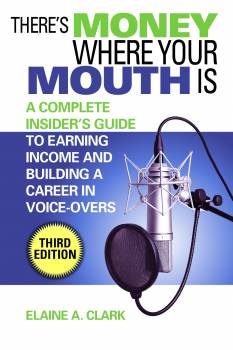|
VOICE ACTING Voicing Lists: Are You Boring? Add Variety With These Musical Scale Patterns  By Elaine Clark By Elaine ClarkVoice Talent, Coach, Author Owner / Founder Voice One Scripts often contain lists. They may include single words, a series of phrases, or several sentences. All these lists, no matter how long or how short, need variety. Each item on the list should sound different from the preceding item. Musically, you need to stair step each list item up, down, or zigzag the notes in the musical scale as tension is built up and released. There are four musical choices:
TRY THIS LIST OF THREE Listing three things is the most common list format, as it follows the "Rule of Three." In the following examples, decide which melodic stair-stepping method is best. When asked to deliver an ABC read (three variations of the same copy), you can use three of the four musical choices to vary each read. What comes in chocolate chip, macadamia nut, and oatmeal? Mr. Garland's cookies, of course! They're baked fresh everyday.Answer: C-D-E By musically stepping each cookie ingredient up the musical scale, it poses the question. Then it requires that the client's name be dropped in pitch to separate it from the last item in the list. "Of course" should be thrown away (read more quickly) and end on a lower note than "Mr. Garland's cookies," in order to establish authority and insight in the company. The third sentence starts low, rises to its highest point at "fresh," and drops back down the musical scale on the final two words to give a definitive ending to the message. Answer: E-D-C Stair-stepping the list down creates a different attitudinal dynamic, as the delivery must shift to a more teasing, knowledgeable, authoritative style. "Mr. Garland's cookies" rises in pitch and "of course" goes even higher as it is thrown away. The final line arrows down the musical scale. Zigzagging the list so that "oatmeal" ends on the middle note means that all the other information needs to jump up and down the scale, as well. If "Mr. Garland's cookies" arrows up, then "of course" does the opposite and arrows down. "They're baked fresh" requires a knowing attitude to sustain the single note delivery before the switch on "every day" to musically end the commercial down. The opposite musical variation occurs when the sentence following the list arrows down, rather than up. This creates a more relaxed, matter-of-fact delivery. OR EMPHASIZE PRODUCT BENEFIT Sometimes the product benefits determine the best way to read the list. Decide whether this list should be read up, down, or zigzagged. For a deep, rich, golden tan, buy Miami Tan.Answer Choices: If you answered up, that would imply that the tan would leave your skin. Zigzagging the list is an adequate choice, and can work when read with the right attitude. Stair-stepping the list down is the best choice because it implies that the tan is going into the skin. One word that should be read quicker or "swallowed" so the listener hardly hears it is "buy." By emphasizing that someone has to spend money, it will negate the sale and the benefits of a sexy tan. ------------------------------------------  ABOUT ELAINE ABOUT ELAINEElaine Clark is an award-winning actor, voice talent, director, producer, certified teacher and author of the book, There's Money Where Your Mouth Is (from which this article is excerpted). She is also the founder and owner of the Voice One in San Francisco, a major voice over training company offering a wide range of voice over classes. Email: vone@aol.com
Web: www.voiceoneonline.com
There's Money Where Your Mouth Is: http://amzn.to/zuwlCT |
As of the NEW website launch, 03/22/2012










I tend to think musically behind the mic since I came from music to voice over. There's music in the words themselves and in how they are displayed within a phrase. With all of the ups and downs, dynamics, textures, pitch and range and emotion of a song. Your examples make this very clear.
Thanks for your thoughts, Elaine!
Take a bright, sparkling female VO, Pam Tierney and add to the copy an Unouncer voice, Doug Turkel. How would that sound? Difficult for people to imagine without guidance so we simply introduce the VO chord.
Play me - A# augmented babe
Want a big league VO to do a monotone read?
Play me - A flat major
Want a V123 VO to do a monotone read?
Play me - A flat minor
Having received 3 on hold announcements you want an additional read that keeps people in a call waiting queue for ever?
Play me - A suspended 4th
Of course if we are to truly master Voice Chords, as opposed to vocal chords, then we must both understand the basics and practice them.
As a Voiceoverist, whilst you may work alone, you must not see yourself out of context. Your note may be C but is it above middle C or below? If we view your note alongside another Voiceoverist whilst you are C, the person who sounds the same as you is more successful, so as a minor needs to give way to a major you declare your note and Key signature as A minor because you are the relative minor to C major.
We also need to contextualize your style and path. Playing alongside side your major it could be that they will always get the body copy and you will always get the tags thus making your a A natural minor. Should your gift enable you to compliment the major in the copy then you are a harmonic minor whereas together with the major you may make music in which case you are A melodic minor.
We are not Voiceoverists we are the VOX Orchestra.